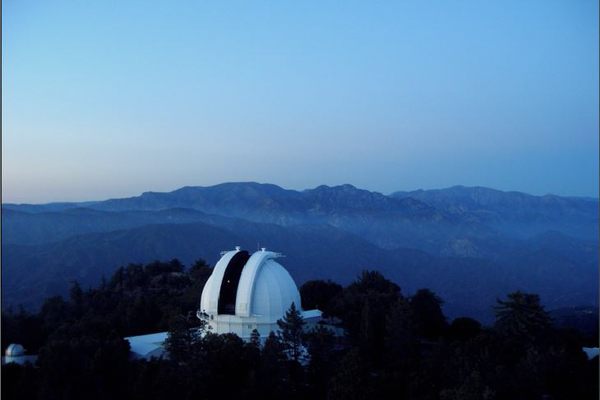Looking Across the Universe at a California Telescope Open to the Public
Saturn shot through the 60-inch telescope at the Mount Wilson Observatory. (photo by Steve Grant)
In 1903, astrophysicist George Ellery Hale went hiking in the San Gabriel Mountains. Resting at the summit of Mount Wilson, he gazed at his surroundings and realized he had found the perfect place to build an observatory. Five years later, at the very same spot, he revealed the world’s largest telescope, a 60-inch reflector that attracted preeminent scientists such as Albert Einstein and Edwin Hubble. In fact, it was with this telescope that Harlow Shapley discovered that the sun’s position was not the center of the Milky Way Galaxy.
An attendee climbs the ladder to view through the 60-inch telescope. (photo by Steve Grant)
As modern astronomy moves into the invisible spectrum, the optical instruments of the early 20th century have become available for public outreach and education. Lucky for us, this is also the fate of Mount Wilson’s 60-inch. On June 29, the LA Obscura Society caravanned up the mountain to gaze at planets, galaxies, and globular clusters.
Viewing through the 22 ton telescope. (photo by Erin Johnson)
Our evening began with the planet Mars, home of the Curiosity and Opportunity rovers. Our session director Shelley Bonus described its appearance as a “bruised apricot.” As we approached the telescope, she advised to have patience while viewing, and between the shimmering of the air currents, we might catch a crystal clear glimpse. As the last rays of light faded, our eyes adjusted to the night. In the low, red light we became a collection of shadows murmuring and wandering about.
LA Obscura Society mingles in the red glow. (photo by Erin Johnson)
Next stop, Vesta, one of the largest asteroids in the Solar System! Squeaking and moaning, the old wooden dome spun above us, while the buzzing motor rotated the telescope until both were in alignment. With one foot on the ladder and one foot braced against the telescope, attendees leaned forward to witness this twinkling potato-shaped rock.
The telescope control station (photo by Kristen Marcum)
My favorite object of the evening was Messier 92, a globular cluster located nearly 27,000 light years away from Earth. This complex concentration of stars appeared as a faint blue spiderweb covered in tiny drops of dew.
The Milky Way (photo by Kristen Marcum)
Living in the photographic age of the Hubble telescope, I was surprised by the subtle and powerful beauty of firsthand observation. Watching objects in their celestial environment revealed shifting colors and dancing air currents. Was the Cat’s Eye Nebula blue or purple? Was the color actually changing, or were my senses playing tricks on me? The light became a living entity that forever changed my perception of the sky.
Thank you, Shelley and Michael for sharing your historic telescope and the beauty of the universe. Afterimages of spiral galaxies, dying stars, and globular clusters will likely continue to haunt all who attended. More photographs from Atlas Obscura’s visit are below, and to learn more about the Mount Wilson Observatory, click here.
Passing by Radio Ridge antenna farm on the way to the Observatory. (photo by Steve Grant)
The dome of the 60-inch telescope (photo by Sandi Hemmerlein)
LA Obscura Society attendees eagerly waiting to enter the dome. (photo by Erin Johnson)
Our incredible Session Director, Shelley Bonus. (photo by Steve Grant)
The Obscura Society is the real-world exploration arm of Atlas Obscura We seek out secret histories, unusual access, and opportunities for our community to explore strange and overlooked places hidden all around us. Join us on our next adventure, and keep up with LA Obscura Society events on our mailing list.











Follow us on Twitter to get the latest on the world's hidden wonders.
Like us on Facebook to get the latest on the world's hidden wonders.
Follow us on Twitter Like us on Facebook